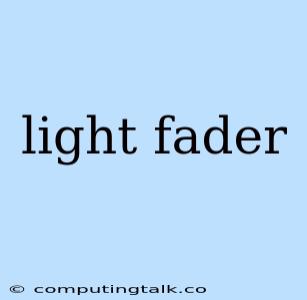The Art of Smooth Transitions: A Guide to Light Faders
Light faders are a fundamental component in various applications, including stage lighting, photography, and even video editing. Their primary function is to control the intensity of light sources, creating gradual and visually appealing transitions. This article will explore the world of light faders, delving into their types, functionalities, and practical applications.
What are Light Faders?
Light faders, also known as dimmer packs or dimmer systems, are devices that regulate the amount of electrical current flowing to a light source. They operate by varying the resistance in the circuit, thereby controlling the brightness of the light.
Types of Light Faders
Light faders come in various forms, each tailored to specific needs:
- Analog Faders: These are the traditional type, employing a physical slider or knob for manual control. They offer precise and responsive adjustments, making them ideal for live performances and theatrical applications.
- Digital Faders: These utilize digital signal processing for precise control and automation. They often feature programmable features and integration with lighting consoles, making them suitable for complex lighting designs and automated shows.
- LED Faders: Specifically designed for LED lighting, these faders offer advanced dimming capabilities, ensuring a smooth and flicker-free transition. They are energy-efficient and typically offer a wider range of dimming options.
Applications of Light Faders
Light faders are indispensable in various fields:
- Stage Lighting: Light faders are crucial for live performances, concerts, and theatrical productions. They enable dynamic lighting changes, creating dramatic effects and enhancing the overall visual experience.
- Photography: Light faders are essential for controlling the exposure and intensity of studio lights, ensuring optimal lighting conditions for photography shoots.
- Video Production: Light faders can be incorporated into video editing software, allowing for seamless transitions and smooth changes in lighting intensity.
- Architectural Lighting: Light faders are used to control ambient lighting in buildings, creating a specific atmosphere and enhancing the architectural design.
How to Choose the Right Light Fader
Selecting the appropriate light fader depends on your specific needs:
- Lighting Type: Consider the type of lights you are using, as different faders are designed for different lighting technologies.
- Control Needs: If you require manual control or automated operation, choose a fader that meets your requirements.
- Power Capacity: The capacity of the light fader should match the total power consumption of your lighting fixtures.
- Features: Choose a light fader with features that align with your specific needs, such as multiple channels, programmable functions, and connectivity options.
Tips for Using Light Faders
- Start Slowly: When adjusting the light fader, start with gradual changes to avoid sudden and jarring transitions.
- Experiment with Timing: Play with different fade speeds to achieve various effects, from subtle transitions to dramatic fades.
- Use Multiple Faders: Incorporating multiple light faders allows for independent control of different lighting circuits, creating complex and dynamic lighting patterns.
- Learn the Basics: Understand the fundamentals of lighting control and the functionalities of your light fader to maximize its potential.
Conclusion
Light faders are essential tools for anyone working with lighting, offering precise control and creative possibilities. Whether for stage lighting, photography, video production, or architectural applications, choosing the right light fader and understanding its capabilities can greatly enhance your artistic vision and technical execution. By embracing the versatility and power of light faders, you can elevate your projects and create truly captivating experiences.
